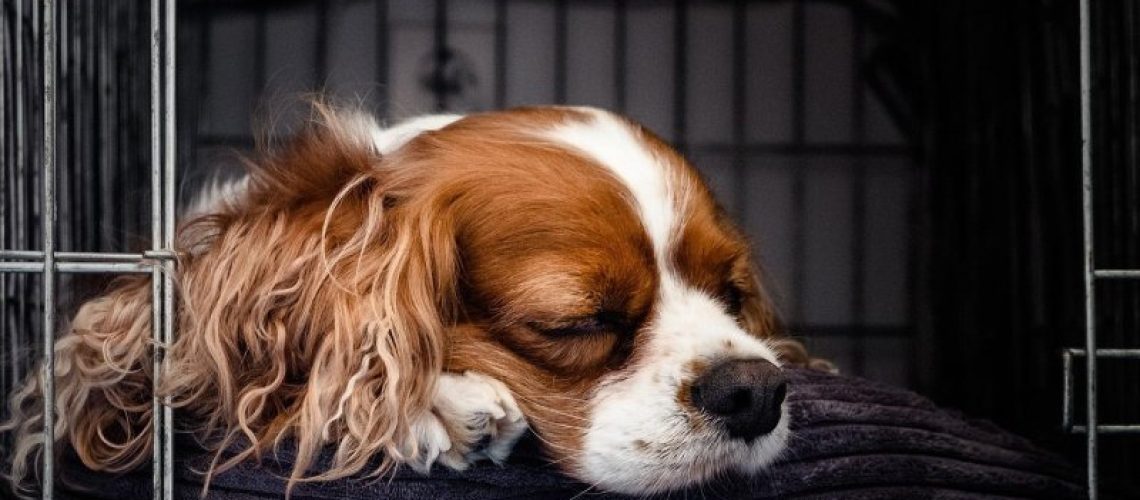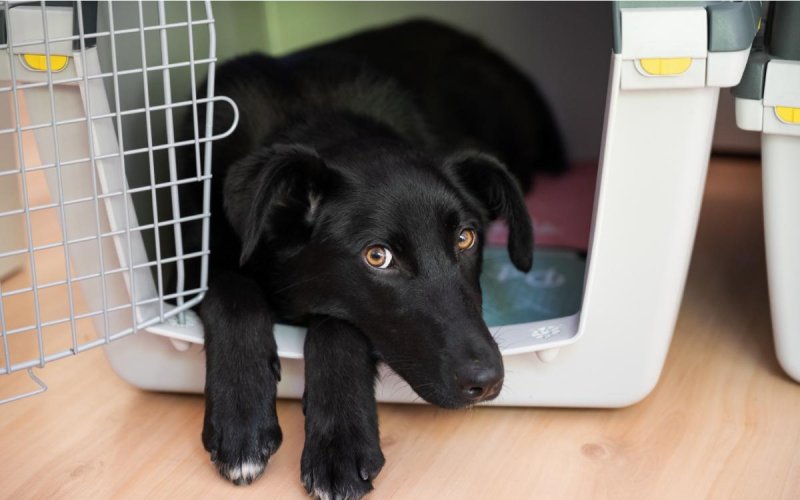Have you ever heard about the concept of “den”? It’s something that’s in the DNA of our dogs. This isn’t new – from wild dogs to our home buddies, they’ve always wanted a safe, snug spot. Even though our modern pets don’t hunt or face predators, they still want their own space. That’s where crate training comes in. And guess what? This isn’t just good for dogs – it’s great for their owners too. Ever thought about the reasons behind crate training or if you should do it for your furry friend?
Well, you’ll learn about the awesome things crate training can do. Excited to get all the details? Let’s jump right in!
1. Safety for Your Dog
Are you thinking about why safety tops the list? Well, dogs naturally look for tight, cozy spots when they feel worried or need a break. They have this ‘denning’ instinct. So, a crate becomes their personal peaceful spot. When your dog is chilling in their crate, it’s important to teach everyone, kids included, to leave the dog alone.
And it’s not just about feeling safe. Keeping your dog safe from getting hurt is a big deal too. Imagine you’re busy making food or your house is getting fixed. If your dog is in their crate, they won’t mess up with the things and this keeps them from getting hurt by accident.
Now, let’s talk more about safety!
Dogs love to explore, right? If you’re not watching, they might go somewhere risky or nibble on stuff they’re not supposed to. That’s dangerous. But if they’re in their crate, you don’t have to worry all the time. The crate stops these bad things from happening, keeping your dog out of trouble.
2. Aids in House Training
Dogs and puppies really don’t want to mess up the place they sleep in. That’s why an appropriately sized crate is so good for teaching your dog when and where to go to the bathroom. You take them to the spot where they should do their business at the right times—like after they wake up or first thing in the morning. This way, they understand that there’s a right place for everything.
Remember, doing the same thing over and over is the trick. Keep up with the routine and always give them a pat on the back when they go to the correct spot. You’ll notice that teaching your dog house manners gets a lot easier.
3. Provide a Personal Space for Your Dog
Dogs are den animals, meaning they naturally love small, snug places just for them. This instinct comes straight from their wild ancestors who used dens to stay safe and take a break. When you give your dog a crate, you’re giving them their own modern den. Domestic dogs, just like their wild relatives, feel secure and comfortable in these spaces.
Benefits of Having a Personal Retreat
- Stress Relief: Sometimes life gets too much for our four-legged pals. It could be the loud bangs of a thunderstorm or the busy buzz of a party at home. A crate is their calm place where they feel protected
- Personal Space: Dogs, like people, need their own space. Their crate is a spot that’s all theirs, where they can snooze, relax, or just be by themselves without any interruption
- Controlled Environment: You can make the crate even nicer by adding their beloved toys, a cozy bed, and even their meals and water. They have all they need in this spot, especially when they feel like some alone time.
4. Eases Travel and Vet Visits
Many dogs find traveling scary. The new places, the movement, the noises—it all can make them nervous. But if they have their crate, it’s like a piece of home to hold onto. They have their own spot, which makes going from one place to another a lot less stressful.
Reducing Anxiety During Travels
- Car Rides: A dog moving around in the car can be dangerous. They could distract the person driving or even get hurt if the car stops quickly. A crate keeps them in one safe place. Also, it can help them feel less worried when they’re riding in the car.
- Vet Stays: There might be times when your dog has to stay at the vet overnight. Having their crate there can really help calm them down. They won’t feel so alone and will probably be able to relax and heal up better.
Table Comparing Anxiety Levels in Dogs During Travel:
|
Dogs with Crate Training |
Dogs Without Crate Training |
|
Short Trips: Low Anxiety |
Short Trips: High Anxiety |
|
Long Trips: Moderate Anxiety |
Long Trips: Very High Anxiety |
|
Vet Visits: Low Anxiety |
Vet Visits: Extremely High Anxiety |
5. Prevents Destructive Behavior
Dogs, especially puppies, are bundles of energy. If this energy isn’t channeled correctly, it can lead to destructive behaviors like chewing your couch or ruining your flower beds. A crate helps by giving them a space where they can have fun with their toys without causing any harm.
- Toys and Distractions: If you put chew toys or puzzles in the crate, your dog has something to do. This keeps them busy and mentally stimulates them.
- Routine and Discipline: Regular crate time can help establish a routine for your dog. Teaching them when it’s time to play and when it’s time to rest becomes super easy
- Protection for Your Belongings: You’ve probably heard tales of dogs that have wrecked shoes or sofas. With a crate, you can stop these things from happening, particularly when you can’t be there to watch over them.
- Safety for Your Dog: It’s not just about your belongings; crates also keep your dog from eating something harmful. If dogs swallow the wrong thing, it can really make them sick.
6. Facilitates Recovery After Surgery or Illness
When dogs get sick or have had surgery, they need a peaceful place away from all the noise and activity that happens every day. This kind of environment helps them get better faster.
- Reduced Movement: It’s super important for dogs to limit their movement after certain surgeries like orthopedic. A crate helps by making sure they don’t walk around too much, which could hurt them or mess up their recovery.
- Staying Away from Other Animals: If your home is a multi-pet household, using a crate can keep your recovering dog away from the others. This stops any roughhousing that could hurt your sick dog.
- Getting Enough Rest: Dogs heal up quicker when they can sleep a lot and not be bothered. Their crate is like a quiet room for them to sleep without any disturbances.
- Medication and Treatment: When dogs are used to their crate, it’s way easier to treat them or give them their medications. They’re less likely to resist in their crates.
7. Enhances Training and Discipline
Every dog needs to know their boundaries inside the house. Sure, cuddles and treats are important, but so is discipline if everyone’s going to live together happily.
- Stay Consistent: Making the crate a regular part of training shows your dog what you want from them. It encourages good actions and stops bad behaviors.
- Cooling Down: Gets too bouncy or starts acting up? A little break in the crate helps them settle. It isn’t a punishment but a moment for them to reset.
- Reward System: If your dog listens well or acts right while crated, show them some love! Maybe a treat, a kind word, or some fun time together.
- Building Trust: Stick to the plan, and your dog will get it. They’ll start to trust how things work, and that makes your bond with them even stronger.
8. Reduces Separation Anxiety & Unwanted Behaviors
Separation anxiety is something a lot of dogs go through. When they’re alone, they may get upset, which leads to them acting out or barking a lot. Crate training can make this better.
- Familiar Environment: The crate becomes a place they know and feel safe in. This means they’re more at ease, even when you’re not there.
- Routine: They understand that crate time is part of the day when you’re gone, which can lessen their worry about being alone.
- Destructive Actions: When it comes to chewing, digging, or trying to run away, these are things dogs with separation anxiety might do. But those behaviors are stopped by the crate, keeping them and your things safe.
- Excessive Barking: As for the barking, a stressed dog could bark non-stop. But the crate, especially with some toys or things they like, can calm them down.
9. Offers Flexibility for Dog Owners
It’s a real comfort to know that your dog is secure and cozy in their crate when you’re out. Whether you’re at the office, doing some shopping, or even on a trip, you can be sure that your pet is safe.
For dog owners, juggling a packed schedule can be tough. The crate is a lifesaver, making sure your dog sticks to their daily routine, no matter how busy you get.
10. Strengthens the Bond Between Dog and Owner
Crate training can really boost the relationship with your dog when it’s done with care and patience. Your dog starts to feel good about their crate, and this good vibe makes the trust between you both even stronger.
As you keep including the crate in your dog’s daily life, communication gets better. Your dog will get your commands more clearly, and you’ll be more in tune with what they need and what they’re trying to tell you.
11. In case of Hurricane/Emergency, you will be able to handle your dog. You never know when an emergency is going to rear its ugly head. If you have to evacuate, or shelter at a large facility, you will need a crate for your dog.
Conclusion
When you handle crate training with care and patience, it brings a wealth of good things for both you and your dog. It’s not only about keeping them in one spot but also about giving them their own secure space. Remember, like all training, you need to be consistent, use positive rewards, and show lots of love. If you start crate training with a positive attitude. You’ll quickly see amazing changes in your dog’s actions and happiness.



